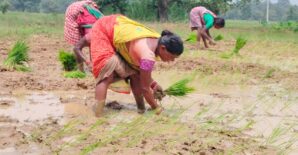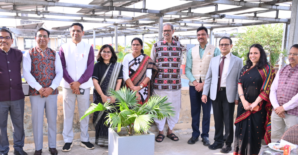
Flickr, Michael Foley
Cross-posted from the FSP India website written by Bas Paris
As India undergoes rapid demographic, economic, and social changes, it is essential for policymakers and development practitioners to gain a deeper understanding of the current and future trends in the agricultural sector, upon which most Indians directly depend for their livelihoods. International Trade and Food Security: The Future of Indian Agriculture, edited by Floor Brouwer and P.K. Joshi, explores the future of Indian agriculture, specifically the expected structural changes in India's agrifood systems over the next ten to twenty years.
Chapter 2 covers the evolution of India’s agricultural and trade policies and highlights key challenges for the agricultural sector and opportunities to overcome the barriers to higher growth. Despite increased liberalization of the entire economy in recent decades and specific growth in the agricultural export sectors, India’s agricultural trade policies continue to be driven mainly by food security concerns. The chapter makes a number of important recommendations, broadly arguing that public investments in irrigation, infrastructure, research, and extension services are key to improving the country’s agricultural sector.
Chapters 3 and 9 examine the nutritional security and income distribution effects of the Mahatma Gandhi National Rural Employment Guarantee Act (MGNREGA). Chapter 3 finds that MGNREGA has contributed to increasing household food consumption, poverty reduction, dietary diversification, and food and nutritional security for poor rural households. Through an examination of the income distribution effects of MGNREGA, however, Chapter 9 finds that poorer households generally do not benefit from MGNREGA and that the program is likely to have a negative impact on the agricultural sector in the long term.
Chapter 4 makes projections for the demand and supply of key food commodities in India by 2020 and 2030. The chapter shows that based on current supply and demand trends, India will continue to meet the demand for wheat through domestic production by 2030. However, In the case of rice, the author estimates that the country may reach an annual deficit of 3-5 million tons per year. India is also likely to face a supply-demand gap for pulses, oilseeds, meats, fruits, and vegetables. The chapter argues that improvements in agricultural productivity will help mitigate these domestic shortages.
Chapter 5 argues that India is currently inadequately integrated with world trade but that trade agreements will assume considerable significance in coming decades. Broadly, the chapter predicts that agri-processing will grow and India will become a net exporter of industrial commodities, but that the country’s agricultural imports will also increase significantly. The author also presents economic scenarios under a bilateral Free Trade Agreement (FTA) with the EU and a multilateral trade agreement in the context of the World Trade Organization (WTO). The study finds that trade agreements in general are good for food security in India and are likely to benefit the poor.
Chapter 6 compares the impact of economic growth and income distribution in urban and rural areas, finding that India’s recent high growth rates have been concentrated in the industrial and service sectors. This has mainly benefitted high-income population groups in urban areas, rather than rural populations. The study estimates that the real income of rural households of the lowest 70 percent of income categories will decrease in coming years under a business-as-usual scenario and argues for supplementary socio-economic measures that benefit the rural poor.
Chapter 7 investigates India’s food safety and quality standards, highlighting that food safety concerns are on the rise and that the 2014 implementation of the Food Safety and Standards Act is likely to have profound effects on the Indian food sector. In the long run, the enforcement of food safety standards will benefit domestic consumers. Additionally, these standards are important to sustain and increase agricultural exports as they are crucial determinants of trade with high-income countries, as well as increasingly so for other developing countries.
Chapter 10 analyses the impact of global price spikes on India’s agricultural price policy. The study finds that through its Minimum Support Price (MSP) scheme and Public Distribution System (PDS), India successfully shielded its domestic market from the global food price spikes and volatility seen in 2007–2008 and 2011. However, these policies did not succeed in preventing price increases over the long run. On the other hand, due to India’s ban on exports, farmers could not profit from the higher global prices; this led them to lobby successfully for a higher MSP.
Chapter 11 examines the international trade implications of India’s biofuel commitments, as well as of biofuel policies in other parts of the world, and finds that external biofuel policies will not reduce poverty in India. While the urban poor will face higher food prices due to these policies, the effect for the rural poor will be dampened because they would benefit from increased agricultural wages. The overall welfare effects of the implementation of India’s national biofuel commitment are found to be negative.
Chapter 12 compares the importance of input subsidies and farm technology for agricultural development. The study observes that investments in irrigation, rural literacy, capacity building, research, and agricultural extension are crucial to increasing agricultural supply. Input subsidies have a positive effect on input use, crop supply, and farm income, while technology improvements have a positive and strong influence on commodity supply and a substantial negative effect on farmers’ incomes. The chapter emphasizes that the input subsidy for farmers and the price subsidy for consumers will not be feasible in the long run, as they demand an increasing share of public resources.
According to Chapter 13, India is the world’s largest producer of milk. In addition, livestock provides a source of income and employment for a large number of rural households (70 million in 2002). However, the chapter argues that livestock productivity remains low compared to other major dairy-producing countries. Thus, increasing dairy productivity can act as an engine of pro-poor growth in India. Similarly, c=Chapter 8 analyses India’s price competitiveness in poultry products with Brazil, the USA, Germany, France, and the Netherlands. The study finds that India has a clear comparative advantage in the case of egg exports but not poultry meat and argues that the removal of India’s poultry tariffs would be disastrous for the domestic poultry industry.
Chapter 14 focuses on modern retail in India and analyses whether the growth in supermarkets is associated with greater demand for specific product features, such as food safety standards. The study finds that the demand for such features remains low. However, a small market segment is interested in such attributes and looks for imported products to satisfy its demand.
In Chapter 15, the editors present the way forward for India’s agricultural sector, including policies for changing business-as-usual scenarios focusing on measures for accelerating agricultural growth, reducing poverty, reforming policies for developing markets, and promoting agricultural trade. Recommendations proposed in this conclusion include increasing public investments, rationalizing subsidies, developing and enforcing food safety standards, expanding the export of high-value commodities, and balancing price support mechanisms.
Options to access the full book can be found here.



